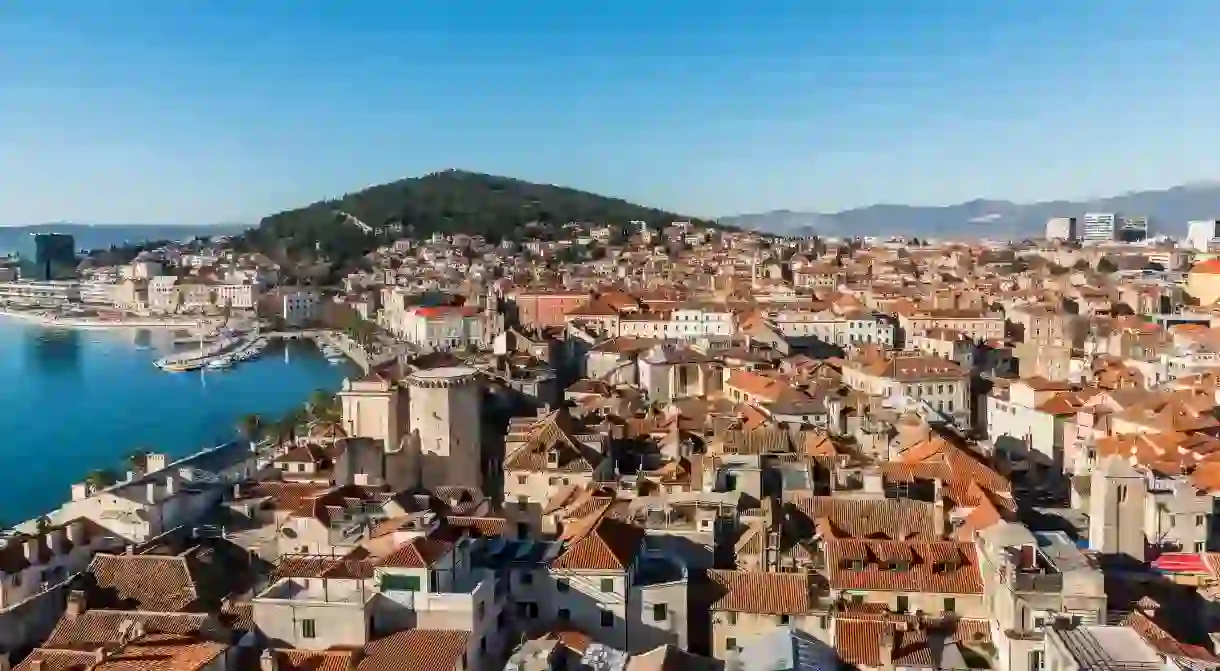Split Neighbourhood Guide: Where To Stay in Croatia’s Second City

Stunning Split is Croatia’s second-largest city, the capital of Dalmatia and home to around 180,000 people, spread throughout a number of diverse neighbourhoods and neighbouring villages. From historic Diocletian’s Palace to football-focused Poljud, discover where to stay on your next trip to Split.
Split’s neighbourhoods, little cities within a city, move in unique ways – though none too far from the steady sway of the Adriatic. Whether it’s up-and-coming Žnjan, the white stone houses of Veli Varoš, or the absolute tranquility of the nearby islands, each of Split’s districts offers something different for the curious urban explorer.
Diocletian’s Palace
While not strictly a neighbourhood, it would be remiss to write about Split without spending a moment or two waxing lyrical about its most famous attraction – a network of streets that have always been the most important part of town. Diocletian’s Palace was built in the 4th century by (or rather, for) the Roman Emperor after which it is named, and served as his home for a while, as well as providing respite and refuge for his soldiers. Today it is the shining jewel in Split’s crown, stretching over a myriad of streets housing restaurants, bars, shops and cafés. The prime attraction here is St Dominus Cathedral.

Veli Varoš
Directly to the west of Diocletian’s Palace lies Veli Varoš, a charming neighbourhood showcasing more traditional white stone architecture and arguably a more genuine local ambience than the one found in the bustling streets of the palace. While the palace is where the emperor lived, Veli Varoš is where the ordinary people of the city went about their business. The slopes of Veli Varoš are home to labyrinthine narrow streets and stunning medieval churches, making the area the perfect spot for a peaceful afternoon stroll.

Lovret
Central Lovret is home to immensely popular burger joint Sexy Cow, which should guarantee it a thumbs up from all hungry visitors. Lovret also houses three serene parks, most notably Emanuel Vidović Park, named after one of the city’s great painting heroes. Lovret doesn’t get the Instagram plaudits that many neighbouring districts do, but it is worth a look for its restaurants, bars and decidedly authentic atmosphere. No pretension here, just real life.
Poljud
If you are a fan of the beautiful game then you may have heard the name Poljud before. This neighbourhood just to the north of the centre of Split is best known for the multi-use arena that dominates it: Stadion Poljud. The 34,198 capacity stadium might be the main event, but there are plenty of other reasons to station yourself in Poljud, namely the beautiful Park Mladosti, home of the increasingly popular Ultra Festival.

Žnjan
Frequently saddled with the “up and coming” tag, Žnjan is the next big thing in the centre of Split. Home to the largest beach in the city, this eastern neighbourhood is all family vibes and colourful blocks, with a mass of much-sought-after buildings overlooking the majesty of the Adriatic Sea. Žnjan is Split at its most idyllic: sand, sea and tranquility, and the Dalmatian seaside holiday vibe that many come to Split in search of. Many of the city’s best accommodation options can be found in Žnjan.
Stobreč
Stobreč feels a million miles away from the heart of town in pace, atmosphere and spirit. Those in search of the “real Split” could do worse than heading this way, where normality abounds while little glimpses of magic still manage to sneak through. Nowhere is this more apparent than the fantastic Konoba Nikola, a restaurant that manages to bridge the divide between authentic homeliness and the fine-dining creativity that defines modern European cuisine.

Vranjic
Heading a little further out of the centre of town, Vranjic is an idyllic village just 10km (6mi) north of Diocletian’s Palace that often gets overlooked by visitors to Split – don’t make that same mistake. This place is known as Little Venice thanks to its quaint charm and position on the sea. So enchanting is Vranjic, that it was supposedly a favourite holiday destination among Romans living in nearby Solin. Just a thousand or so people live here, enjoying the historical architecture, the Split Aquarium and the sombre sounds of traditional Croatian music (head to the Church of St Martin to find out more).

Solin
A neighbouring town to the north of Split, Solin matches its big brother for historical importance every step of the way. It was in Solin (then called Salona) that Diocletian was born into a fairly inconspicuous Dalmatian family before rising through the ranks to become emperor; and needless to say, Solin is very proud of its most famous son. There are several important archeological sites here, none more so than ruins of the town’s amphitheatre.

Brač
Fifty minutes by boat from Split, Brač is the largest island in Dalmatia. It is also home to one of the region’s most famous beaches – the stunningly beautiful Zlatni Rat, an expanse of sand that changes shape with the wind. The serene town of Supetar is the centre of life on Brač, home to a Baroque-style church (the Church of Saint Peter) and a mass of stunning Baroque architecture, much of which seems to carry a vaulted air of grace when compared to equivalents on the mainland. Ferries run between Split and Brač all day long, giving visitors plenty of opportunities to visit one of the most idyllic Croatian islands.

Šolta
The journey from Split to Solentium (as it was known in Latin) takes less than an hour, and the island is becoming an increasingly popular spot for lovers of wine worldwide. Viticulture has been developing here since people first took interest in the alcoholic qualities of grapes, and it continues to grow as Dalmatian wines continue to convert more oenophiles. Sipping great wine against the backdrop of the turquoise Adriatic in Šolta makes for a gorgeous getaway from the hustle and bustle of central Split.














